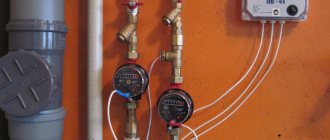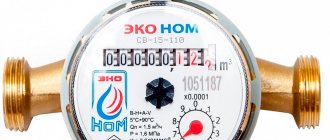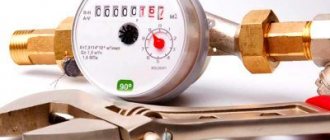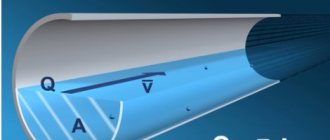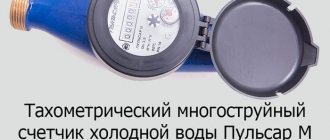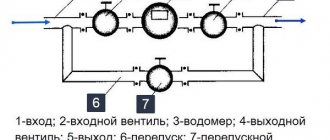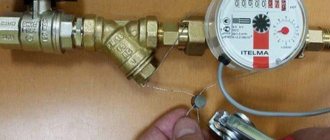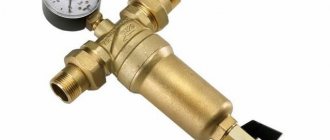Utility organizations that provide hot water supply services often do not care about maintaining the minimum temperature set for hot water.
In this case, the user is required to pay for the entire volume of water coming from the hot tap, regardless of its temperature.
In order to save money and control the quality of DHW service, a hot water meter with a temperature sensor is installed.
It measures the volume and temperature of water and then enters it into the appropriate tariff cell.
Based on the Decree of the Government of the Russian Federation No. 307 “On the procedure for providing utility services to citizens” dated May 23, 2006, water with a temperature above 40 degrees is paid at the hot water tariff. If the temperature does not correspond to the norm, then payment is charged as for cold water.
What it is?
A hot water flow meter with a temperature sensor is a multi-tariff meter that allows you to constantly monitor the temperature of water, record them electronically, allocating the volumes of used water into tariff cells.
This function allows the consumer to pay for DHW with a low temperature at the price of a cold one . A conventional water meter includes the following elements: an impeller in contact with water and a gearbox that transmits the impeller revolutions to a mechanical display through a magnetic gear.
Unlike this water meter, a multi-tariff device consists of three main parts:
Mechanical , which includes an impeller mounted on the turbine.
The number of its revolutions per unit time depends on the volume of water passing through the blades. An inductive (reed switch) sensor is attached to the turbine, reporting pulse data on the amount of water consumed.- Electronic unit that collects information about the amount of hot water used and its temperature.
- Temperature sensor , recording readings at certain intervals and transmitting them to the electronic unit via a cable connection.
On the display of the electronic unit, depending on the model of the device, you can see:
- the total volume of water passing through the blades;
- temperature;
- the amount of low-temperature water used is less than 40, 50ᵒС (correction factors are applied to them when calculating the total volume of water).
Some meter models may be equipped with a port for remote transmission of readings.
For this, a special device is used, which can be located at a decent distance from the electronic unit (about 10 m) and read its data. It is very convenient to take readings outside the apartment when the owner is not at home.
Description and principle of operation of the device
A meter is an individual device for metering the amount of water consumed per unit of time.
When paying for utilities, previous indicators are taken into account - they are subtracted from the figures current at the time of filling out the receipt.
The operating principle of a hot water meter depends on the type:
| Type | Description |
| Tachometer | The amount of resource consumed is calculated by rotating the wing element. It is located in a compartment protected from moisture and rotates from the flow of passing liquid. Indications are indicated on a special dial |
| Ultrasonic | Liquid flows through the water meter, and the calculation is carried out by measuring the acoustic vibration of ultrasound |
| Magnetic | The magnetic field is induced in proportion to the strength of the flow of incoming water |
| Vortex | In the plumbing system, vortices are formed, rotating proportionally to the rate of liquid inflow, due to which its consumption is calculated |
Tachometer ones are considered popular and reliable. They have been installed for several decades and are characterized by an extended service life.
Operating principle
When liquid is supplied through the flow meter, the impeller begins to rotate. Its movement provokes a signal about the amount of flowing water to be sent to the reading device.
At the same time, at short intervals, a signal is received from a temperature sensor that measures the water temperature.
The electronic unit calculates water consumption and records its temperature.
Depending on the temperature of the liquid, these readings are recorded in a specific cell. There are two and four tariff meters. The first ones keep records of water up to 40ᵒС and above.
When such a device operates, data is recorded in 2 cells. Next, they are multiplied by the required coefficients and added to the total volume of water consumed.
Four-tariff devices are smart water meters; they more accurately measure the volumes of water consumed in different temperature ranges using correction factors.
In such counters, the signal from the impeller and temperature sensor is recorded in 4 cells. Distribution across cells and application of coefficients.
| Cell no. | Temperature range of water, ᵒС | Correction factor, Kp |
| 1 | < 40 | 0 |
| 2 | 40 – 44,9 | 0,7 |
| 3 | 45 – 49,9 | 0,9 |
| 4 | ≥ 50 | 1 |
Subsequently, the 4 values of the volumes of water used are summed up in the electronic unit, taking into account correction factors, and the overall result of the hot water consumed is displayed.
Warranty period of operation and verification of flow meters
The warranty period for metering devices is indicated by the manufacturer in the passport. Upon purchase, the store issues a warranty card.
For various models, the manufacturer provides its own warranty. Usually no more than 30-48 months from the start of operation of the meter.
Verification of metering devices is regulated in the regulatory framework of Russia (Federal Law “On Ensuring the Uniformity of Measurements” dated June 26, 2008 N 102-FZ, Decree of the Government of the Russian Federation dated May 6, 2011 N 354 (as amended on July 13, 2019)).
In the passport, the manufacturer must indicate the calibration interval for a specific meter model. For multi-tariff configurations, it is usually no more than 3-4 years. If the manufacturer specifies an interval of more than 4 years, then this issue is resolved at the local level by the regulatory organization.
Measurement and accounting of hot/cooled water.
I. Kuznik Ph.D.;
A. Malov.
Most of us remember the cult New Year's comedy by Eldar Ryazanov, “The Irony of Fate or Enjoy Your Bath,” which is still shown on many television channels in our time. And Hippolytus’ phrase, which he said while taking a shower in the bathroom. After almost a five-minute dialogue between the film’s characters, who in no way wanted to rub Ippolita’s back, he (in the person of actor Yuri Yakovlev) said, “Oh, the lukewarm one has gone!”
Many citizens are familiar with this “problem” not only from the film; they regularly encounter this in their apartments, draining a large amount of cooled water from the hot water tap into the sewer, waiting for warm water to flow.
And if earlier this problem did not bother citizens much in connection with paying for hot water according to the standard, then after the installation of meters and the increase in tariffs, this problem acquired significant interest.
When pouring cubic meters of cooled hot water into the sewer, the homeowner incurs additional costs for paying for the drained volume of water while waiting for “warm water”. Prices for hot water and cold water: one cubic meter of hot water in Moscow costs 163 rubles 24 kopecks, and a cubic meter of cold water costs 23 rubles 43 kopecks. The difference is almost 140 rubles per cubic meter. This mainly affects residents living in houses built during the Soviet Union, in which the hot water supply (DHW) system has a dead-end wiring and, due to the lack of circulation, the hot water in the pipeline cools down overnight. But there are also new housing in which the builders, not without the participation of designers, have created a similar hot water supply system. And sometimes you have to drain the “hot” water for half an hour to take a shower.
Anyone who studied physics well at school can remember the formulas and calculate how much water flowed before it became warm, and if there is a meter, even a layman who has forgotten the formulas can determine how much water went down the drain. But performing calculations while standing in the shower with a thermometer and at the same time monitoring the meter readings every time you decide to wash yourself is not entirely convenient.
The SAYANY company has developed and produces a hot water meter “Profit RMD” (“Sayany-T RMD”) which will make the necessary measurements and calculations without distracting you from water procedures.
The hot water meter has a built-in thermometer and measures hot water consumption based on temperature:
V1 – volume of all DHW water measured by the meter (V1= V1g+ V1x);
V1g – volume of water that passed through the meter with a temperature above Тpore (default 40°С);
V1х – volume of water passing through the meter with a temperature below Тpore;
V1 report, V1g report, V1x report – meter readings as of the date of the reporting period.
The meter has an archive in which the hourly values of the measured volume and temperature of water passed through the meter with a temperature above the set value Tpore (V1g) are stored.
The meter has a radio interface that allows you to automatically transmit accumulated readings and hourly archives for the last 2 months (mail and/or SMS).
Of course, the meter is certified and included in the state register SI RF 69115-17. However, when introducing these meters into operation, citizens are often faced with the reluctance and inability of the management company (RSO) to use the readings of such meters to pay for consumed hot water.
This article outlines the main issues that arise when commissioning Profit RMD meters, designed for metering hot water with temperature control and paying for the provided public service for hot water supply based on the readings of an individual device (IPU), and explains how to overcome the difficulties caused by obstacles from outside management companies (MCs) and resource supply organizations (RSOs) in organizing the accounting of the provided low-quality public hot water supply services and subsequent calculations, within the framework of current legislation.
The procedure and rules for accounting for utility services for hot water supply using IPU, the calculation procedure is regulated by the Rules “On the provision of utility services to owners and users of premises in apartment buildings and residential buildings” approved by Decree of the Government of the Russian Federation No. 354 of 05/06/2011. (hereinafter referred to as the Rules). Please note that any attempts by the Criminal Code and RSO to refer to the norms of other documents, including the rules for commercial metering of heat and hot water supply, are illegal , because in our case we receive a public service for hot water supply.
In accordance with clause 33 of the Rules, the owner is given the right to make a decision on the installation of an individual metering device, namely:
h) make a decision on the installation of an individual , general (apartment) or room metering device that meets the requirements of the legislation of the Russian Federation on ensuring the uniformity of measurements, including a metering device whose functionality makes it possible to determine the volumes of consumed utility resources differentiated by time of day or other criteria , reflecting the degree of use of communal resources, even if such an individual or common (apartment) metering device differs in functionality from the collective (general house) metering device with which an apartment building is equipped , and apply for the installation of such a metering device to the persons carrying out the corresponding Kind of activity.
In turn, the contractor providing public services for hot water supply (a management company or RSO can act as a contractor if there is a direct agreement with the consumer - the owner of the premises) by virtue of clause 31 of the Rules has an obligation, namely:
s) carry out, at the request of the consumer, the commissioning of an installed individual , common (apartment) or room metering device that complies with the legislation of the Russian Federation on ensuring the uniformity of measurements, even if such an individual or common (apartment ) metering device differs in functionality from the collective (common house) metering device metering device with which an apartment building is equipped, no later than the month following the date of its installation, and also begin calculating the amount of payment for utilities based on the readings of the metering device put into operation, starting from the 1st day of the month following the month of commissioning metering device into operation.
At the same time, the same paragraph of the Rules directly states that the performer is obliged to:
r) not create obstacles for the consumer in exercising his right to install an individual , common (apartment) or room metering device that meets the requirements of the legislation of the Russian Federation on ensuring the uniformity of measurements, including a metering device whose functionality makes it possible to determine the volume (quantity) of consumed utilities resources differentiated by time of day (established periods of time) or by other criteria reflecting the degree of use of communal resources, even if such an individual or common (apartment) metering device differs in functionality from the collective (community) metering device with which an apartment building is equipped.
Thus, all kinds of “excuses” of the management company and RSO about the impossibility of accepting the Profit RMD IPU into operation and making payments for the provided utility service on the basis of its testimony contradict the Rules.
By virtue of clause 80 of the Rules: Accounting for the volume (quantity) of utility services provided to the consumer in residential or non-residential premises is carried out using individual, common (apartment), room metering devices . Metering devices of an approved type and verified in accordance with the requirements of the legislation of the Russian Federation on ensuring the uniformity of measurements are allowed for use. Information about the compliance of the metering device with the approved type, information about the date of initial verification of the metering device and the calibration interval established for the metering device, as well as requirements for the operating conditions of the metering device must be indicated in the accompanying documents to the metering device (passport).
The individual metering device Profit RMD fully complies with the requirements of the legislation of the Russian Federation on ensuring the uniformity of measurements and is included in the RF SI register No. 69115-17.
At the same time, some management companies and RSOs justify their refusal to commission a water meter by defining it as a heat meter. However, this statement is incorrect and is refuted by the description of the device type, which is published in the SI register.
Please note that the contractor’s obligation to commission the IPU and make calculations based on its indicators begins from the moment the consumer (owner) submits an application to put the device into operation. The procedure for filing an application is established in clause 81 of the Rules, namely:
Equipping residential or non-residential premises with metering devices , putting installed metering devices into operation, their proper technical operation, safety and timely replacement must be ensured by the owner of the residential or non-residential premises.
Putting the installed metering device into operation , that is, documenting the metering device as a metering device, according to the readings of which the amount of payment for utilities is calculated, is carried out by the contractor on the basis of an application from the owner of a residential or non-residential premises submitted to the contractor.
The application contains the following information:
information about the consumer (for an individual - last name, first name, patronymic, details of an identity document, contact telephone number, for a legal entity - name (company name) and place of state registration, contact telephone number);
proposed date and time of commissioning of the installed metering device;
type and serial number of the installed metering device, location of its installation;
information about the organization that installed the metering device;
meter readings at the time of its installation;
date of next verification.
The application is accompanied by a copy of the passport for the metering device, as well as copies of documents confirming the results of the last verification of the metering device (with the exception of new metering devices).
The installed meter must be put into operation no later than the month following the date of its installation. In this case, the contractor is obliged, starting from the day following the day the metering device is put into operation, to calculate the amount of payment for the corresponding type of utility service based on the readings of the metering device put into operation .
Clause 5 of Appendix No. 1 of the Rules establishes quality criteria for the provision of public services for hot water supply. In accordance with the above standards, the temperature of hot water in places of water collection, regardless of the heat supply system used, must be no lower than 60 and no higher than 75 degrees Celsius, ... when the temperature of hot water drops below 40 degrees Celsius, payment for consumed water is made at the rate for cold water.
The main reasons for the refusal of the management company and the RSO to accept the readings of the IPU Profit RMD are indicated in the absence of an act on the provision of low-quality utility services and a reference to the fact that, according to clause 5 of Appendix No. 1 of the Rules for recalculation, it is necessary to provide data for each hour of hot water supply, the temperature of which is analysis point below 40 °C, cumulatively during the billing period.
In themselves, these requirements are absurd, but they can be easily fulfilled. To do this, along with the transmission of the IPU readings, attach an act on the provision of a service of inadequate quality (free form) signed by the consumer with the requirement to sign by the contractor (you can simply report this to the emergency dispatch service by phone with the requirement to enter the message in the log). Attach to the act a printout of the archived readings of the IPU for the reporting period (month), which shows data on the time of hot water supply below 40 degrees, the total time and amount of poor-quality service.
Similar actions must be taken if your hot water temperature at the point of analysis (namely, this is where the meter is installed) is above 40, but less than 60 degrees Celsius. In this case, the Management Company (RSO) is obliged to recalculate based on a printout of the archived data of the IPU readings based on clause 5 of Appendix No. 1 to the Rules, namely: for every 3 degrees deviation from the permissible deviations from the hot water temperature (at night from 00.00 to 05.00 by no more than 5 degrees, in the daytime from 5.00 to 00.00 hours by no more than 3 degrees) the amount of payment for utility services for the billing period in which the specified deviation occurred is reduced by 0.1 percent of the amount of payment determined for such billing period in accordance with the requirements of the Rules, for each hour of permissible deviations, in total during the billing period, taking into account the provisions of the Rules.
No excuses from the management company or RSO for refusing to allow the meter into operation are legal, because The rules state:
- The date and time from which it is considered that the utility service is provided with quality violations are:
c) the date and time of the beginning of the violation of the quality of public services, which were recorded by a collective (community), common (apartment), individual metering device or other measuring device that is intended for these purposes and is used in accordance with the requirements of the legislation of the Russian Federation on the uniformity of measurements, if the specified metering devices and measuring instruments are capable of storing recorded information.
If a refusal to accept testimony follows, you should contact the State Housing Inspectorate and/or the court. Please note that the consumer has the right to sue at the place of residence, and not at the location of the defendant (UK, RSO), because this dispute is governed by the Consumer Protection Law.
When contacting the management company and the RSO regarding the issues of accepting the IPU into operation and carrying out calculations based on their testimony, it would be useful, in case of refusal, to remind them of the provisions of the Rules on the responsibility of the performer and the norms of the Law on the Protection of Consumer Rights, given below. The same standards should be indicated when applying to court for restoration of the violated rights of the consumer - the owner of the premises.
According to the Rules:
- The Contractor bears administrative, criminal or civil liability established by the legislation of the Russian Federation for:
a) violation of the quality of provision of public services to the consumer ;
b) harm caused to the life, health and property of the consumer due to a violation of the quality of provision of utility services, due to failure to provide the consumer with complete and reliable information about the provided utility services;
c) losses caused to the consumer as a result of the contractor’s violation of consumer rights, including as a result of an agreement containing conditions that infringe on the consumer’s rights in comparison with these Rules;
d) moral harm (physical or moral suffering) caused to the consumer as a result of the contractor’s violation of consumer rights provided for by the housing legislation of the Russian Federation, including these Rules.
- The contractor who has committed a violation of the quality of provision of a utility service due to the provision of a utility service to a consumer of inadequate quality and (or) with interruptions exceeding the established duration, is obliged, in accordance with the provisions of these Rules, to recalculate to the consumer the amount of payment for such a utility service in the direction of reducing it until complete release consumer from paying for such a service.
The consumer has the right to demand that the contractor also pay penalties (fines, penalties) in the amount specified in the Law of the Russian Federation “On the Protection of Consumer Rights” in the cases specified in paragraph 157 of these Rules.
- When the contractor provides the consumer with utility services of inadequate quality and (or) with interruptions exceeding the established duration, the consumer has the right to demand that the contractor pay penalties (fines, penalties) in the amount specified in the Law of the Russian Federation “On the Protection of Consumer Rights” in the following cases:
a) if the contractor, after concluding an agreement containing provisions on the provision of utility services, does not promptly begin to provide utility services;
b) if the total time of interruptions in the provision of utility services for the billing period exceeds the permissible interruptions in the provision of utility services established in Appendix No. 1 to these Rules;
c) if... the temperature of hot water at the point of water collection does not meet the requirements established by the legislation of the Russian Federation;
g) if the emergency dispatch service does not register a consumer message about a violation of the quality of utility services or their failure to provide them;
h) in other cases provided for by the contract.
In addition, according to the provisions of the Consumer Rights Protection Law, your rights are protected by the following legal provisions:
Article 4. Quality of goods (work, services)
- The seller (performer) is obliged to transfer the goods to the consumer (perform work, provide a service ), the quality of which corresponds to the contract .
- If there are no conditions in the contract regarding the quality of the product (work, service ), the seller ( performer) is obliged to transfer to the consumer the product (perform work, provide a service ) that meets the usual requirements and is suitable for the purposes for which a product (work, service) of this kind is usually used .
- If laws or the procedure established by them provide for mandatory requirements for a product (work, service ), the seller ( performer ) is obliged to transfer to the consumer a product (perform work, provide a service) that meets these requirements.
Article 29. Consumer rights when discovering deficiencies in the work performed ( service provided )
- When discovering deficiencies in the work performed ( service provided), the consumer has the right, at his own discretion, to demand :
free elimination of deficiencies in the work performed (service provided);
corresponding reduction in the price of work performed ( service provided );
reimbursement of expenses incurred by him to eliminate deficiencies in the work performed (service provided) on his own or by third parties.
Satisfying the consumer's demands for the gratuitous elimination of defects, for the manufacture of another item, or for the repeated performance of work (provision of a service) does not relieve the contractor from liability in the form of a penalty for violating the deadline for completing the work (provision of a service).
The consumer has the right to refuse to fulfill the contract for the performance of work (rendering a service) and demand full compensation for losses if, within the period established by the specified contract, the shortcomings of the work performed (service provided) are not eliminated by the contractor. The consumer also has the right to refuse to fulfill the contract for the performance of work (provision of a service) if he discovers significant deficiencies in the work performed (service provided) or other significant deviations from the terms of the contract.
The consumer also has the right to demand full compensation for losses caused to him in connection with deficiencies in the work performed (service provided) . Losses are compensated within the time limits established to satisfy the relevant consumer requirements.
- Claims related to deficiencies in the work performed ( service provided ) may be presented upon acceptance of the work performed ( service provided) or during the performance of the work ( service provided ) or, if it is impossible to detect deficiencies upon acceptance of the work performed ( service provided), within the deadlines established by this paragraph.
The consumer has the right to make claims related to defects in the work performed ( service provided ) if they are discovered during the warranty period, and in its absence, within a reasonable period, within two years from the date of acceptance of the work performed ( service provided ) or five years in relation to the defects in buildings and other real estate.
I would like to draw your attention to the fact that the Law on the Protection of Consumer Rights is paramount in relation to the Rules, as a by-law.
By applying in practice the information presented in the article, you can count on the reasonable behavior of the management company and the RSO within the framework of the current Legislation.
The company is ready to provide all possible support to consumers using SAYANY brand products, including representing interests in judicial and administrative authorities.
After the consumer contacted us and we sent a complaint to the Ministry of Construction and Housing and Communal Services of the Government of the Russian Federation, clarifications were given from the Department of Energy, Housing and Utilities of Novosibirsk, which resolved the issues of allowing devices to be put into operation in the city.
In addition, there is judicial practice (Krasnoyarsk, Volgograd, Yaroslavl) in which the courts made decisions in favor of citizens who installed an individual Profit RMD metering device, with the obligation of the management company to accept the IPU into operation and make calculations based on its readings.
The information presented in the article is intended to help citizens defend their legitimate interests and save money by paying only for the quality service consumed.
Advantages and disadvantages
When purchasing them, you need to evaluate the possibility of installation and operation, taking into account the following advantages:
- This category of meters provides a complete analysis of the volume of water consumed in different temperature ranges and makes a fair calculation of the hot water used (t> 50ᵒC).
- Economic benefit for the family budget (cold water from a hot tap will be paid at the cold rate).
- In legal disputes with utility services over the poor quality of the service provided, the truth will be on the side of the consumer with a multi-tariff meter in which you can see the temperature of the measured liquid.
- Reliability of these flow meters.
- Easy to maintain.
Disadvantages include:
- The high cost of a water meter compared to a conventional model (usually it pays for itself in 3-4 years).
- Sometimes difficulties arise when registering a meter.
Attention! Some hot water suppliers refuse to accept such meters because they do not properly maintain the water temperature according to the standards.
This issue is being resolved in court.
Hot water meter with temperature sensor: pros and cons
Before purchasing a water meter equipped with a temperature sensor, it is recommended to study all the advantages and some disadvantages of this device. This will allow you to assess the feasibility of its acquisition. Let's look at the advantages of this type of hot water meter.
The main advantage of a multi-tariff hot water meter of this type is, of course, that its use allows you to save money. Conventional measuring instruments record the total water consumption, but they do not differentiate by heating temperature. As a result, all cubic meters of liquid have the same price quoted by the service provider, and this does not contribute to savings.
The main advantage of a hot water meter with a temperature sensor is that its use allows you to save
Helpful information! The installation of such metering devices is especially justified if it is necessary to control the supply of hot water in an apartment located on the upper floors of the house. This is due to the fact that water rarely reaches the upper tiers with the standard parameters specified in the regulatory documentation.
Another advantage of a hot water meter with a temperature sensor is its reliability. The internal mechanism of water meters of this type is highly resistant to adverse factors affecting its parts during operation.
Meters equipped with temperature sensors are easy to maintain. In addition, it should be noted that the use of such a device makes it convenient to record readings. The water meter display can be placed in any convenient place, thereby providing free access to the information displayed on it.
Like any other device, such a water meter also has its negative sides. Water meters with temperature sensors are quite expensive, which often stops buyers. Another disadvantage of such a device is problems with its registration. Some management organizations refuse to seal a water meter of this type. To resolve this issue, it is recommended to go to court, since every citizen has every right to install a water meter equipped with a temperature sensor.
The disadvantage of a hot water meter with a temperature sensor is the problem with its registration
In what case should you choose such a metering device?
An electronic meter with a thermometer is not suitable for every consumer. The product should not be purchased if water of normal temperature (at least 50ᵒC) flows from the hot water tap after 30-60 seconds of supply.
Here are the main reasons for purchasing a water meter with a sensor:
Failure to comply with temperature standards for hot water supply by the supplier company (SanPiN 2.1.4.2496-09 as amended as of April 2, 2021).- The location of living space in a high-rise building is on the upper floors. Heat loss from the working fluid occurs when ascending to the upper floors.
- Absence of most neighbors on the hot water riser. Because of this, there is little circulation in the tract.
Advice! Before purchasing a multi-tariff meter, you must consult with a specialist in installing devices and housing department employees.
Rules and selection criteria
The main criteria for choosing a multi-tariff meter are the technical characteristics of the hot water supply system, which can be provided by the service provider and determined by the consumer himself:
- Working pressure in the pipeline.
- Maximum water temperature.
- The diameter of the pipe where the meter will be installed (the installation location is determined by a specialist).
For a water meter, the following data is taken into account:
- Operating pressure.
- Nominal flow.
- Conditional pass.
- Type of installation.
- Measurement error.
Nominal flow, operating pressure and nominal size are taken into account according to the characteristics of your system. The type of installation (horizontal or vertical) is selected depending on the installation location. The accuracy of calculating the volume of water consumed depends on the measurement error.
In order not to make a mistake when buying a water meter, you must adhere to some rules:
Take into account the material of the connections; the better it is (brass, stainless steel), the more durable the operation will be.- Choose a well-known manufacturer that has a state license to manufacture this type of device (domestic models will be cheaper).
- It is better to make a purchase at specialized sales points (even if you have to pay a little more than on the market), which will provide a guarantee for the product and can replace it in case of malfunction.
- The verification interval indicated in the passport should be taken into account.
- Before purchasing, carefully inspect the product for damage.
- Slowly check the compliance with the declared contents in the passport and in the packaging.
It is important to know! It is better to look on the Internet for the approximate cost of the model you plan to purchase in order to avoid buying a fake at a lower price.
Tips for choosing
Most buyers who want to purchase a hot water meter strive to find a product from a well-known brand, with a reliable design, minimal error and at an affordable price .
When choosing a model that meets these requirements, do not forget about equally important characteristics:
- water pressure;
- operating temperature;
- maximum value of the adder;
- sensitivity limit;
- permissible pressure loss when installing a flow meter.
No one is safe from purchasing low-quality products or counterfeits, so before purchasing, ask the seller to present certificates confirming the authenticity and quality of the goods.
Popular models
The most popular water meter models are described in the table below.
| Brand of meter with temperature sensor | Main characteristics |
| SAYANY-T | Accuracy grades 1 and 2 are manufactured. Overall dimensions: 80x70x75 mm. Weight 0.2 kg. Service life ≥ 12 years. Interverification interval is 4 years. Approximate price – from 3500 rubles. and higher |
| ELEHANT SVD-15 | Allows you to take readings remotely using a smartphone or portable display. The base is made of brass. The inter-verification interval is 6 years. Service life ≥ 12 years. Approximate price – 915 rubles. |
| "Archimedes" | The body is brass, overall dimensions: 110x82x85. Weight 0.55 kg. Volume measurement error: 3-5%. Maximum pressure – 1 MPa. Intervalidation interval – no more than 3 years. Approximate price – 4000 rubles. |
Now new models from other manufacturers are appearing on the market of metering devices. For a successful purchase, you should look at the technical characteristics of each type and decide which device is suitable for use in an apartment or office.
Dubious savings
How much can you save when installing the device? There is no exact answer to this question, since each owner of a living space has different losses due to overpayment for hot water. But rarely does anyone start paying less than half the previous cost of hot water. Conventionally, we can assume that a certain family “N” of three people saves 150 rubles. per month. Total for the year is 1800 rubles, and you will need about 3.5 years to recoup the device with a total cost (including installation) of 6000 rubles. And every four years the meter needs to be checked, and not all devices pass the test: for example, “Sayany-T-RMD” is rejected in 50% of cases. So the device will most likely pay for itself, but the savings will be insignificant.
How to connect in an apartment?
The installation principle of a device with a temperature sensor is the same as that of a conventional water meter. It is better to do installation through a specialized company . Self-installation is not excluded if the consumer has certain skills in working with plumbing equipment.
Materials and tools for independent work:
- Valve.
- Filter.
- Check valve.
- Grinder for cutting and cleaning.
- If necessary, depending on the installation location - bends, corners.
- Wrench or adjustable wrench.
- Soldering iron for plastic systems.
- Sealants – silicone or FUM tape, tow.
Basic plan for installing a metering device:
- The water in the system is shut off using the main valve.
- The pipe section is cut (the length corresponds to the length of the meter with a set of connecting elements) on which the water meter is planned to be installed.
- The cut areas are thoroughly cleaned of contamination with fine sand particles.
- A valve must be installed in front of the device (a ball valve can be used).
- A coarse filter with sealing material is carefully screwed onto the valve (it is better to check the number of threads before doing this, without seals, so as not to over-tighten).
- Attach mounting fittings with nuts to the valve and check valve and fasten a pipe corresponding to the length of the meter instead of the water meter.
- Pressure flush the system and remove the pipe.
- Place gaskets on the fittings and, using nuts, mount the meter on them. The direction indicator on the body of the device must correspond to the flow of water.
- The coupling is inserted into the check valve and the system is hermetically sealed using soldering (for a plastic pipeline) or fittings (for metal structures).
- The device is stabilized using clamps or other fasteners.
- The system is tested with overpressure for leaks within a few minutes.
In the future, it is necessary to draw up the relevant documents and seal the water meter.
Attention! All elements of the system are installed without excessive tension, distortion or clamping.
Operation and Maintenance
Let's consider the procedure for using the device. The display is turned on by pressing the indication button. After 30 seconds of inactivity, the display turns off.
For advanced mode, you must press the button and hold for more than 3 seconds. In this state, the water meter displays information for 1 minute, then turns off if there is no action on the part of the user.
The extended display mode is usually not of interest to the consumer . It shows the factory parameters - time of exposure to the magnetic field, blocking changes to adjustment parameters, impulse coefficient and program code version.
When you press the button further in extended mode (if 1 minute has not passed), the display shows the volumes of water consumed in different temperature ranges.
Maintenance
Digital devices require periodic inspection and testing by the user.
About once a month you need:
- Check the housing for integrity.
- Turn on the hot water supply and visually monitor the product in operation.
- Inspect the tightness of connections.
- Check seals.
- Wipe the water meter from dust and dirt.
The product should be verified within the appropriate time frame with the help of a special organization licensed for this type of activity.
Main types of breakdowns
A water meter with a temperature sensor is a mechanism that can fail, regardless of whether it was used correctly or not. Possible defects can be identified at an early stage by undergoing scheduled maintenance.
There are several signs of meter failure, by which the user can determine when specialist intervention is necessary:
- lack of signals from the device;
- incomplete display or complete absence of information on the display;
- the indications of the mechanism do not correspond to the daily norms of water consumption;
- the meter housing or protective covering is broken or cracked.
The most common cause of meter failure is the supply of low-quality water with impurities. Contamination can only be detected using special equipment.
Over time, waste and rust from pipes can accumulate in the counting device, as a result of which the mechanism becomes clogged and refuses to work.
In some cases, major breakdowns or damage will require a complete replacement of the meter with a new one. If you can limit yourself to partial repairs, then it takes place in several stages:
- Dismantling.
- Disassembly and washing.
- Replacement of faulty parts.
- Assembly, installation followed by performance testing.
A meter with a temperature sensor has its own service life, after which the equipment is checked or replaced. Self-repair is impossible, even if repair kits were sold.
Calling a specialist is impractical, because... After dismantling the broken unit, a temporary one is installed. Then the temporary one is dismantled, a repaired one is installed and it is not a fact that it will work for a long time. It is cheaper and faster to install a new water meter.
